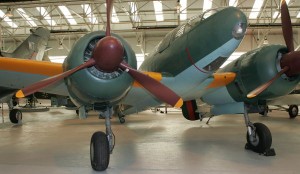 Although fighter and ground attack versions of the Dinah were developed, it was as a high-altitude photographic reconnaissance aircraft that the Ki-46 was most successful. Indeed, it was so successful that Germany tried to acquire manufacturing rights from Japan.
Although fighter and ground attack versions of the Dinah were developed, it was as a high-altitude photographic reconnaissance aircraft that the Ki-46 was most successful. Indeed, it was so successful that Germany tried to acquire manufacturing rights from Japan.
The Ki-46 first flew in November 1939 . The top-speed of 540 km/h was 60 km/h slower than required, but it was still faster than the latest Japanese fighters! New engines were attached during 1941, and the Dinah reached its required speed of 600 km/h. The Mark III Dinah which is the one I will be modelling here, had further improved engines, and a more stream-lined cockpit area, giving it a speed of 630 km/h.
The aircraft was first used over China, but the most successful missions were those flown over British Malaya before the Japanese invasion. Its high-altitude capabilities and long range meant that the Dinah could cover the entire Pacific theatre with almost no opposition.
The Dinah became vulnerable to fast-climbing Allied fighters at the end of the conflict, but still made many reconnaissance missions over the large American air-bases in the Mariana Islands at the end of the war.
Specifications:
Crew: 2 (pilot and observer)
Length: 11.00 m (36 ft 1 in)
Wingspan: 14.70 m (48 ft 2¾ in)
Height: 3.88 m (12 ft 8¾ in)
Empty weight: 3,263 kg (7,194 lb)
Loaded weight: 5,050 kg (11,133 lb)
Max. takeoff weight: 5,800 kg (12,787 lb)
Powerplant: 2 × Mitsubishi Ha-102 Army Type 1 14-cylinder radial engine at 1,080 hp
Maximum speed: 604 km/h (326 knots, 375 mph) at 5,800 m (19,000 ft)
Cruise speed: 400 km/h (217 knots, 249 mph)
Range: 2,474 km (1,337 nmi, 1,537 mi)
Service ceiling: 10,720 m (35,200 ft)
Climb to 8,000 m (26,250 ft): 17 min 58 sec
Guns: 1× rearward-firing 7.7 mm (.303 in) Type 89 machine gun





 22/09/2012
22/09/2012
Leave a reply